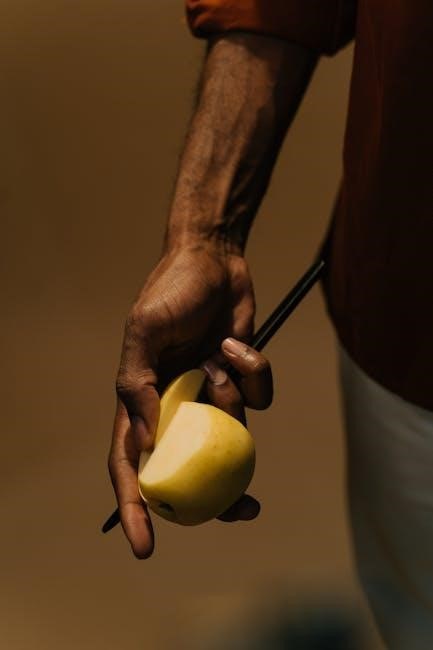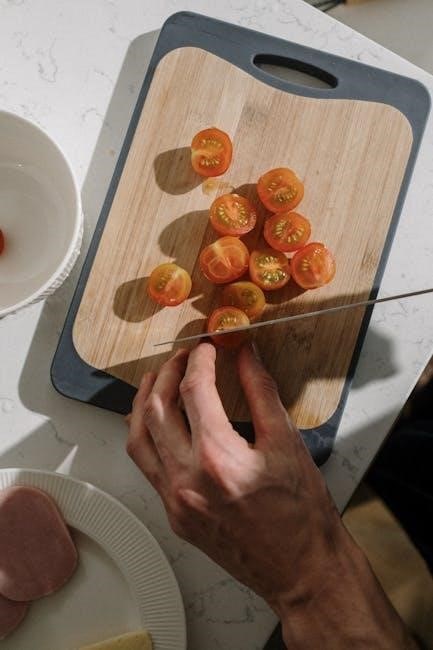Knife sharpening with an angle guide ensures precision and consistency, helping you achieve professional results. This tool simplifies the process, transforming dull blades into razor-sharp edges effortlessly.
1.1 Understanding the Importance of Angle in Knife Sharpening
The angle in knife sharpening is critical as it determines the edge’s geometry and sharpness. A proper angle enhances cutting efficiency, edge retention, and durability. Incorrect angles can lead to uneven edges or reduced sharpness. For instance, thinner blades require narrower angles for precision, while thicker blades benefit from wider angles for strength. Maintaining the correct angle ensures optimal performance for specific tasks, making it a foundational skill in knife sharpening.
1.2 Benefits of Using an Angle Guide for Consistent Results
An angle guide ensures consistency during knife sharpening, eliminating guesswork and variability. It helps maintain the same angle throughout the process, leading to a more precise and durable edge. This tool is especially beneficial for beginners, as it simplifies achieving professional-level sharpness. With an angle guide, users can focus on stroke technique, knowing the angle remains constant, resulting in consistently sharp knives tailored to their specific needs and preferences.

Choosing the Right Sharpening Angle for Your Knife
Choosing the right sharpening angle is crucial for optimal knife performance. It depends on the knife type, intended use, and manufacturer recommendations. Common angles range from 15 to 30 degrees, with kitchen knives typically at 20 degrees and Japanese knives slightly lower. Correct sharpening enhances durability and precision.
2.1 Standard Sharpening Angles for Different Types of Knives
Standard sharpening angles vary based on knife type and use. Kitchen knives typically range from 15-20 degrees, while hunting knives are sharper at 22-25 degrees. Fillet knives require a more precise 16-18 degrees for clean cuts. Serrated knives often use a slightly lower angle, around 17-19 degrees. The angle should align with the knife’s intended purpose and original factory edge for optimal performance and durability.
2.2 How to Determine the Optimal Angle for Your Knife
To determine the optimal sharpening angle, consider the knife’s intended use, blade type, and manufacturer guidelines. Match the angle to the factory edge for consistency. For unknown angles, start with a universal angle like 20 degrees. Use an adjustable sharpener or angle guide to maintain precision. Always prioritize the knife’s original design specifications to preserve its performance and edge integrity, ensuring a sharp, durable blade tailored to its purpose.
Types of Angle Guides and Sharpening Tools
Angle guides and sharpening tools vary, including diamond stones, ceramic rods, and adjustable sharpeners like the Lansky QuadSharp. These tools offer precision and versatility for different knife types and needs.
3.1 Overview of Popular Angle Guide Kits
Popular angle guide kits include the SHARPAL 196N Angle Pyramid and Lansky QuadSharp. These tools offer preset angles like 17°, 20°, and 25°, ensuring consistency. Diamond and ceramic stones are common, with diamond stones being aggressive for quick edge restoration and ceramic stones ideal for finishing. Adjustable sharpeners allow customization, while guided systems simplify maintaining the perfect angle for various knife types, from kitchen knives to serrated blades.
3.2 Diamond, Ceramic, and Arkansas Stones for Precision Sharpening
Diamond stones are aggressive and fast, ideal for restoring edges on hard steel. Ceramic stones excel at finishing, removing minimal metal for a sharp edge. Arkansas stones, made of silica novaculite, polish blades to razor sharpness with minimal metal removal. Each stone type complements angle guides, ensuring precise sharpening for various knife needs, from aggressive restoration to fine polishing, catering to different steel types and sharpening goals effectively.

Step-by-Step Guide to Sharpening with an Angle Guide
Start by preparing your knife and sharpening tool. Position the knife at the desired angle using the guide. Stroke evenly, maintaining consistent pressure and angle for optimal results.
4.1 Preparing Your Knife and Sharpening Tool
Begin by inspecting your knife for damage or dullness. Position the blade at the desired angle using the guide, ensuring alignment with the sharpening tool. For precision, place the knife edge against the guide’s slot, matching the factory edge angle. Lightly hold the tool, maintaining consistent pressure. Use a marker to mark the bevel for visibility. Start sharpening with light strokes, progressing evenly across the blade. Finish with a leather strop for a polished edge.
4.2 Maintaining Consistency in Sharpening Angle
Maintaining a consistent sharpening angle is crucial for achieving a razor-sharp edge. Use the angle guide to align the blade precisely, ensuring the same angle on both sides. Apply light, even pressure, and move the knife in smooth strokes. Repeat the process, checking the edge regularly. For visibility, mark the bevel with a marker. Continue until the edge is sharp, then finish with a leather strop to polish and refine the blade.
4.3 Finishing the Edge with a Leather Strop
Finishing the edge with a leather strop polishes the blade, enhancing sharpness and removing micro-scratches. Apply a small amount of stropping compound to the strop for optimal results. Hold the knife at the same angle used for sharpening and drag it across the strop in smooth, trailing strokes. Alternate sides with each pass to ensure even polishing. Repeat until the edge gleams, then wipe clean to remove any compound residue, revealing a razor-sharp finish.

Manufacturer-Recommended Sharpening Angles
Manufacturers often specify ideal sharpening angles for their knives, ranging from 15 to 25 degrees, depending on the knife type and intended use. Always refer to these guidelines for optimal results.
5.1 Sharpening Angles for Major Knife Brands
Major knife brands often specify ideal sharpening angles for their products. Wüsthof recommends 14-15 degrees, while Shun and Global suggest 16-17 degrees. Spyderco typically uses 20 degrees, and Victorinox ranges from 15-20 degrees. SOG recommends 18-22 degrees depending on the grind type. Benchmade and Kershaw often use 18-20 degrees. These angles are designed to maintain the knife’s original edge characteristics and performance. Always refer to the manufacturer’s guidelines for precise results.
5.2 Adjusting the Angle Based on Knife Type and Use
Knife type and usage dictate optimal sharpening angles. Straight razors require 7-8 degrees, while fillet knives use 16 degrees. Hunting knives are sharpened at 22 degrees, and tactical knives at 20-22 degrees. Asian-style kitchen knives prefer 15-17 degrees, and Western knives 20 degrees. Adjusting the angle ensures the blade’s edge meets its intended task, whether precision cutting or robust outdoor use, enhancing both performance and longevity. Always tailor the angle to the knife’s specific purpose for best results.
Maintaining Consistency and Avoiding Common Mistakes
Maintaining a consistent sharpening angle is key to achieving razor-sharp edges. Avoid common mistakes like inconsistent pressure and incorrect angle alignment, which can damage the blade.
6.1 Tips for Consistent Angle Maintenance
Maintaining a consistent sharpening angle is crucial for achieving sharp, even edges. Use an angle guide to ensure precision and avoid deviations. Light pressure and smooth strokes help preserve the angle. Visualize the desired angle before starting and align the knife’s spine with the guide marks. Regular practice on inexpensive knives builds muscle memory, enhancing consistency. For added precision, use a marker to highlight the edge, making it easier to track progress during sharpening.
6.2 Common Mistakes to Avoid During Sharpening
Common mistakes include applying too much pressure, which can damage the blade. Inconsistent angle maintenance leads to uneven edges. Using the wrong grit or skipping the stropping step can leave the knife dull. Over-sharpening or failing to inspect the edge regularly wastes time and material. Avoid using improper techniques, as they can create nicks or rounded edges. Keep the knife steady and follow the guide to ensure precise results every time.

Sharpening Rods and Their Role in Angle Precision
Sharpening rods, like diamond and ceramic, refine edges with precision. They maintain consistent angles and complement angle guides, ensuring razor-sharp results for all knife types.
7.1 Using Diamond and Ceramic Rods for Different Needs
Diamond rods excel for heavily damaged blades, quickly restoring edges, while ceramic rods are ideal for light touch-ups and maintaining sharpness. Both provide consistent angle precision, ensuring durability and efficiency for various knife types and sharpening needs.
7.2 How Sharpening Rods Complement Angle Guides
Sharpening rods work seamlessly with angle guides, enhancing precision and control. Diamond rods handle heavy-duty sharpening, while ceramic rods refine edges. Together, they ensure consistent angles and even sharpening, addressing specific blade needs. This combination optimizes sharpening efficiency, making it ideal for both beginners and experienced users seeking professional-grade results.
The Role of Stropping in Finishing the Edge
Stropping is the final step in sharpening, polishing the blade to a razor-sharp edge. Using a leather strop with compounds enhances sharpness and removes micro-scratches for a refined finish.
8.1 Understanding the Stropping Technique
Stropping involves dragging the knife’s edge across a leather or synthetic surface, typically with a stropping compound. This step polishes the blade, removing microscopic scratches and creating a razor-sharp edge. The motion is performed by pulling the knife backward across the strop, maintaining the same angle used during sharpening. Light pressure is essential to avoid damaging the edge. Regular stropping extends the blade’s sharpness and ensures optimal performance for various cutting tasks.
8.2 Enhancing Sharpness with Stropping Compounds
Stropping compounds, like chromium oxide or diamond, enhance sharpness by refining the blade’s edge. Applied to the strop, these compounds polish the metal, removing microscopic imperfections. This step ensures a razor-sharp finish without over-sharpening. Light pressure and consistent strokes maintain the knife’s angle, preserving its integrity. The result is a precise, durable edge tailored for optimal performance in various cutting tasks, making stropping an essential final step in the sharpening process.
Knife sharpening with an angle guide requires consistency and patience. Mastering the technique ensures razor-sharp edges. Always use the right tools and practice to refine your skills.
9.1 Summarizing Key Points for Effective Knife Sharpening
Effective knife sharpening relies on maintaining the correct angle, using the right tools, and consistent practice. Always use an angle guide for precision and select sharpening tools like diamond or ceramic stones. Regular maintenance ensures a razor-sharp edge. For most knives, a 20-degree angle is ideal, while high-end or Asian knives may require 15-17 degrees. Finish with a leather strop for a polished edge. Consistency and patience yield the best results.
9.2 Encouragement to Practice and Refine Skills
Consistent practice is key to mastering knife sharpening. Start with basic techniques and gradually refine your skills. The satisfaction of achieving a razor-sharp edge is rewarding and enhances your daily tasks. Even small improvements can make a significant difference in performance. Keep experimenting, stay patient, and enjoy the journey of becoming a skilled sharpener!
